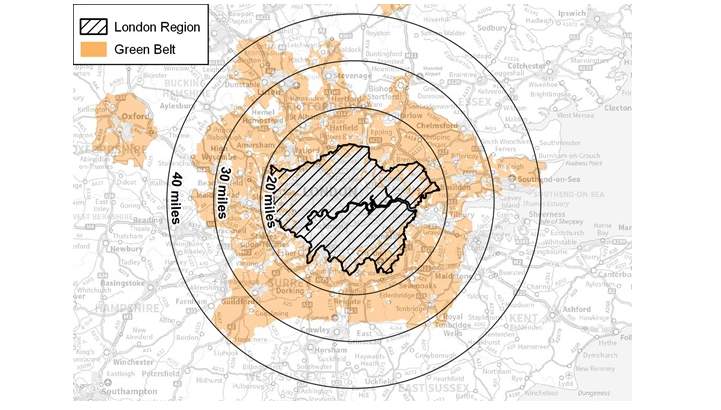The target in the emerging London Plan represents a shortfall of 20,000 homes per annum against the Government’s standard approach to calculating local housing need (LHN). This shortfall will need to be accommodated elsewhere, in markets linked to the capital. However, at present there is no formal mechanism to ensure this happens, and areas best placed to accommodate need are heavily constrained by green belt.

One solution will be to meet London’s shortfall through areas in the immediate surrounding area. But despite their proximity, areas closely connected to London are not necessarily well suited to meeting the overspill. Our analysis looks at the capacity for development around 20, 30 and 40 miles from the city centre.
There are 27 Local Planning Authorities (LPAs) with at least part of their boundary falling within 20 miles of the City of London. Between them, these local authorities have delivered an average of 10,330 homes per annum over the past five years. So a tripling of current efforts would be required to meet London’s need, an unlikely scenario in the short term.
The 50 LPAs across the 30-mile zone are similarly poorly placed, requiring an increase of 80 per cent to current annual delivery rates in order to meet London’s overspill. This appears particularly challenging when considering there are 474,000 hectares of greenbelt within the LPAs, equating to almost half of their total combined area.
So those areas at least partly falling within the 40-mile zone would be a realistic solution. Current rates of delivery plus London’s shortfall would mean increasing the housing stock across these 67 LPAs by 1.4 per cent each year. This rate of increase would make the zone comparable to high-growth LPAs like Vale of White Horse, Dartford, Uttlesford and Cherwell.
However, this proposed rate of growth would require all 67 LPAs to work towards substantially increasing their housing supply, and not all of the areas are served by the right amount of infrastructure to sustain that level of growth. The type and scale of developments capable of delivering this quantity of housing would likely require serious strategic planning.
Strategic solutions
In November 2017, the Government announced that it was committed to building up to one million homes across the Oxford to Cambridge corridor by 2050. This pledge arrived alongside plans to build a new road connecting the two settlements. The Oxford to Cambridge Expressway is a key part of wider infrastructure investment plans aimed to encourage economic growth in the area, as explored in our report released late last year, The Oxford-Cambridge Innovation Arc.
The ambitious targets for housing and clear plans to invest in infrastructure make this economic corridor well placed to accommodate a least part of London’s overspill. The key challenge will be finding the most suitable way to deliver high volumes of good quality homes. Efforts will need to be made to ensure diversity in type, tenure and size of property delivered in the corridor to ensure sufficient market absorption in order to meet the high demand for additional homes.
One option could be through the Government’s garden settlements agenda, with 21 settlements gaining backing to build a total of 211,500 homes in the latest round of funding. One characteristic of existing large garden settlements, however, is a slower pace of delivery. Ebbsfleet is a 15,000-home garden settlement in Kent that has faced a series of delays due to restricted provision of road and utility links.
It’s clear that new settlements will be part of the solution for meeting London’s housing need, but consideration will need to be given to bringing forward smaller sites in order to adequately address the immediate undersupply in the short term.
Further information
Read more: The problem with London housing targets
.jpg)









.jpg)